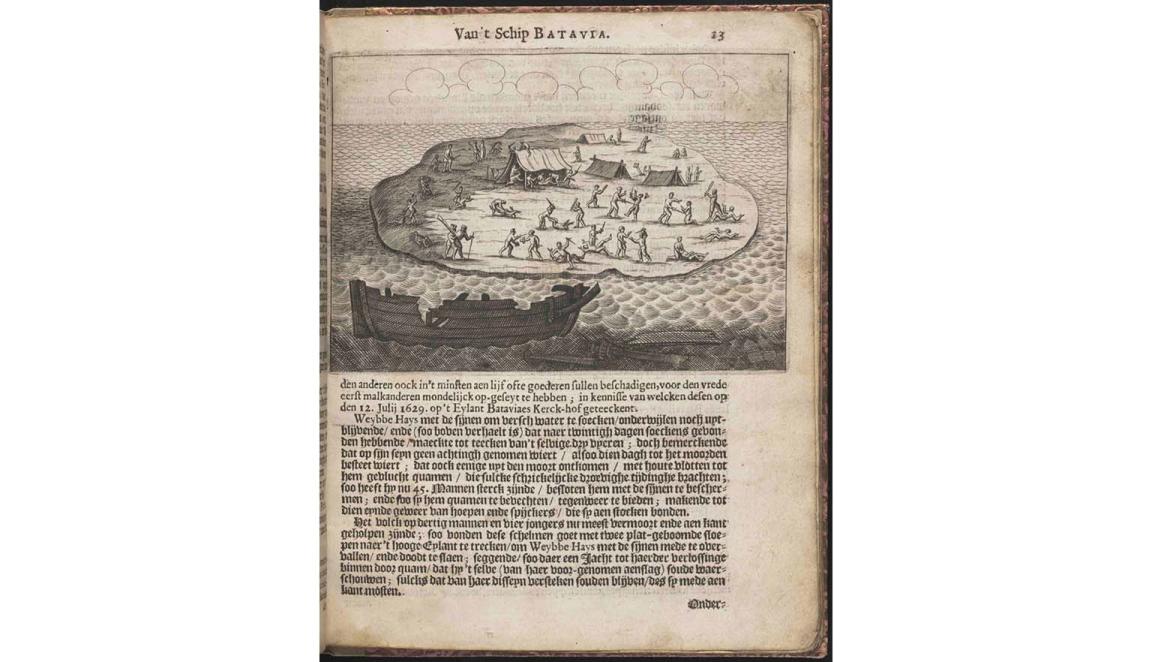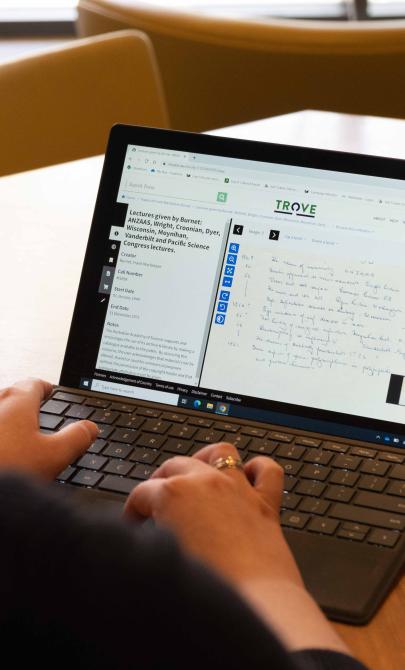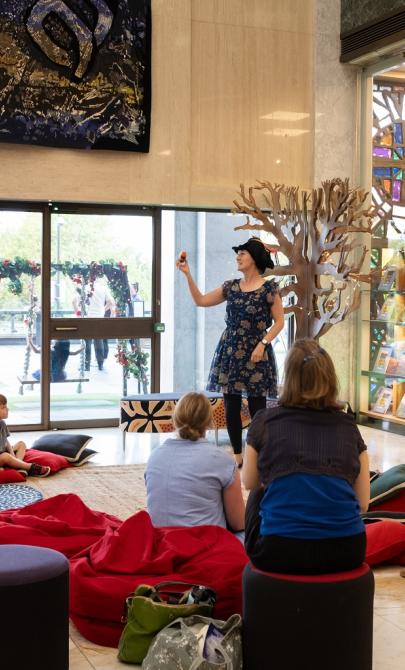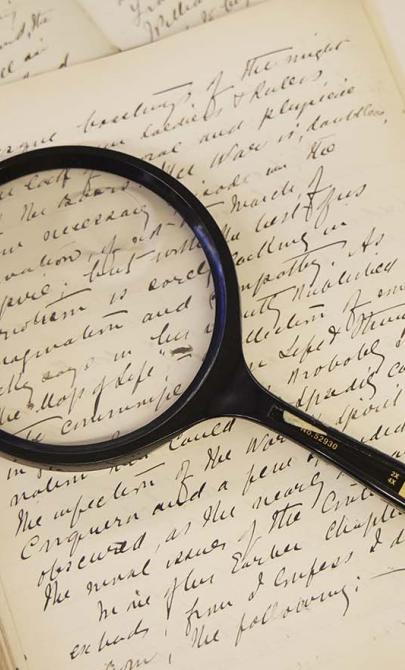Shipwrecked!
Summary
At least four VOC ships were wrecked on the Western Australian coast in the 1600s and 1700s. These included:
- the Batavia in 1629
- the Vergulde Draeck (Gilted Dragon) in 1656
- the Zuytdorp in 1712
- the Zeewijk in 1727
Other shipwrecks may still be discovered. Many ships were lost between the Netherlands and the East Indies during the VOC’s 200-year reign.
The tragic tale of the Batavia
The wreck of the Batavia is one of the most disturbing stories in Australian history.
On its first voyage in 1628, the Batavia left Texel, the Netherlands, bound for the East Indies. It carried over 300 people, mostly VOC officers and soldiers, but also civilians—including women and children—heading to join family.
The ship was led by merchant Francisco Pelsaert, with Ariaen Jacobszoon as captain and Jeronimus Cornelisz as third in command.
Soon after departure, Jacobszoon and Cornelisz plotted to take over the ship and use it for piracy. But before they could act, the Batavia was separated from its fleet in a storm and wrecked on the Abrolhos Islands, off the coast of what is now Geraldton, Western Australia.
Some passengers drowned. Around 180 survivors reached nearby islands in lifeboats. Cornelisz and about 70 men stayed behind on the wreck.
With no fresh water on the islands, Pelsaert sailed to Batavia (now Jakarta) to get help. While he was away, Cornelisz took control. Claiming to search for water, he divided the group and then led a brutal campaign, murdering many of the remaining survivors.
Pelsaert returned to a scene of horror. Cornelisz was captured, had his hands cut off, and was executed on Seal Island. Others were taken to Batavia for trial and execution. The ship’s treasure was lost until the wreck was discovered in 1963.
Pelsaert’s journal
Captain Francisco Pelsaert’s journal, Ongeluckige Voyagie (or ‘Unlucky Voyage’) reveals the horrors in dramatic illustrated detail. The Library's copy is the rare Utrecht edition, which included not only new illustrations, but additional eye-witness accounts from wreck survivors.

Francisco Pelsaert, Ongeluckige voyagie van't schip Batavia na Oost-Indien uyt-gevaren onder de E. Franç̧ois Pelsaert : gebleven op de Abriolhos van Frederick Houtman op de hooghte van 28 en een half graden by Zuyden de Linie Equinoctiael : vervattende 't verongelucken des schips, en de grouwelijcke moorderyen onder 't scheeps-volck, op't eylandt Bataviaes Kerck-hoff nevens de straffe der handtdadigers in de Jaren 1628 en 1629 ; hier achter is by- gevoeght eenige discourssen der Oost-Indische Zee-vaert als mede de gantsche gelegentheyt der Koopmanschappen diemen in Indien doet., 1649, nla.gov.au/nla.obj-39984464
Francisco Pelsaert, Ongeluckige voyagie van't schip Batavia na Oost-Indien uyt-gevaren onder de E. Franç̧ois Pelsaert : gebleven op de Abriolhos van Frederick Houtman op de hooghte van 28 en een half graden by Zuyden de Linie Equinoctiael : vervattende 't verongelucken des schips, en de grouwelijcke moorderyen onder 't scheeps-volck, op't eylandt Bataviaes Kerck-hoff nevens de straffe der handtdadigers in de Jaren 1628 en 1629 ; hier achter is by- gevoeght eenige discourssen der Oost-Indische Zee-vaert als mede de gantsche gelegentheyt der Koopmanschappen diemen in Indien doet., 1649, nla.gov.au/nla.obj-39984464
Learning activities
Activity 1: Who’s who on the Batavia?
Have students research the main characters on the Batavia and answer:
- Who were they and what were their roles?
- What relationships or tensions existed between them?
- Why did Cornelisz and Jacobszoon want to mutiny?
- Who do you think was most responsible for what happened?
Activity 2: Timeline of events
In groups, have students:
- Create a timeline from the Batavia’s departure in Texel to the trials of the mutineers in Batavia
- Place on the timeline Pelsaert’s journal images
- Choose additional key events to illustrate and add to the visual display
Display the full illustrated timeline on the classroom wall.
Activity 3: Other VOC wrecks
Introduce students to three other known Dutch shipwrecks:
- Vergulde Draeck (1656)
- Zuytdorp (1712)
- Zeewijk (1727)
Lead a class discussion:
- Who owns a shipwreck?
- Should wreck sites be protected or open to visitors?
- What can shipwrecks teach us about history?
Watch the short video Batavia Shipwreck Ruins from the series Australia’s Heritage – National Treasures with Chris Taylor.
Protecting the past
To protect VOC shipwrecks, the Australian Netherlands Committee on Old Dutch Shipwrecks (ANCODS) was established. It manages thousands of artefacts recovered from the wrecks, many of which are displayed in museums around the world.
Activity 4: Discovering the past
Using Trove, have students research the discovery and salvage of VOC shipwrecks off the Western Australian coast. Research questions:
- What artefacts have been found?
- Where are they kept today—and why?
- Who is responsible for preserving them?
Students can create a themed Pinterest wall showcasing artefacts, memorials, statues and sites related to the Batavia. Each item should include an accurate historical description.
Activity 5: Dutch–Indigenous connections
Some survivors of Dutch shipwrecks may have lived with local Aboriginal communities—and some may have had descendants.
Using Trove and trusted online sources, students investigate:
- What evidence is there of Dutch heritage among First Nations people?
- What theories or projects are exploring this connection?



